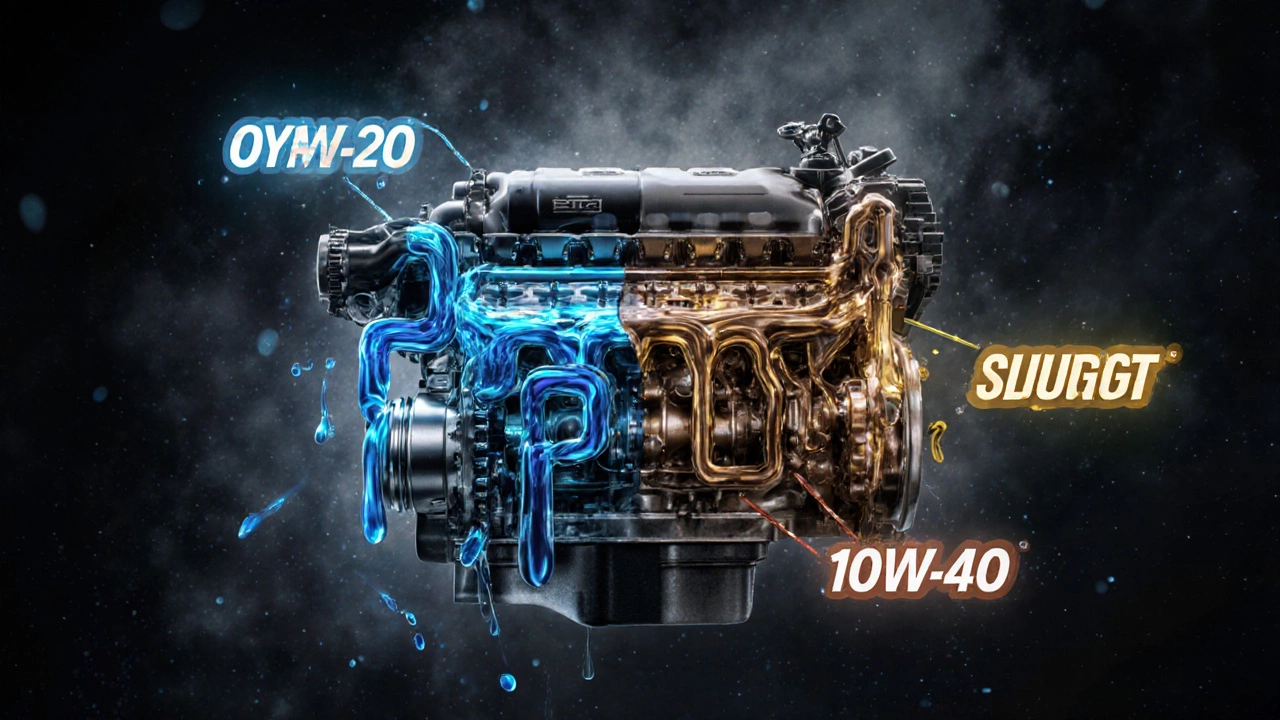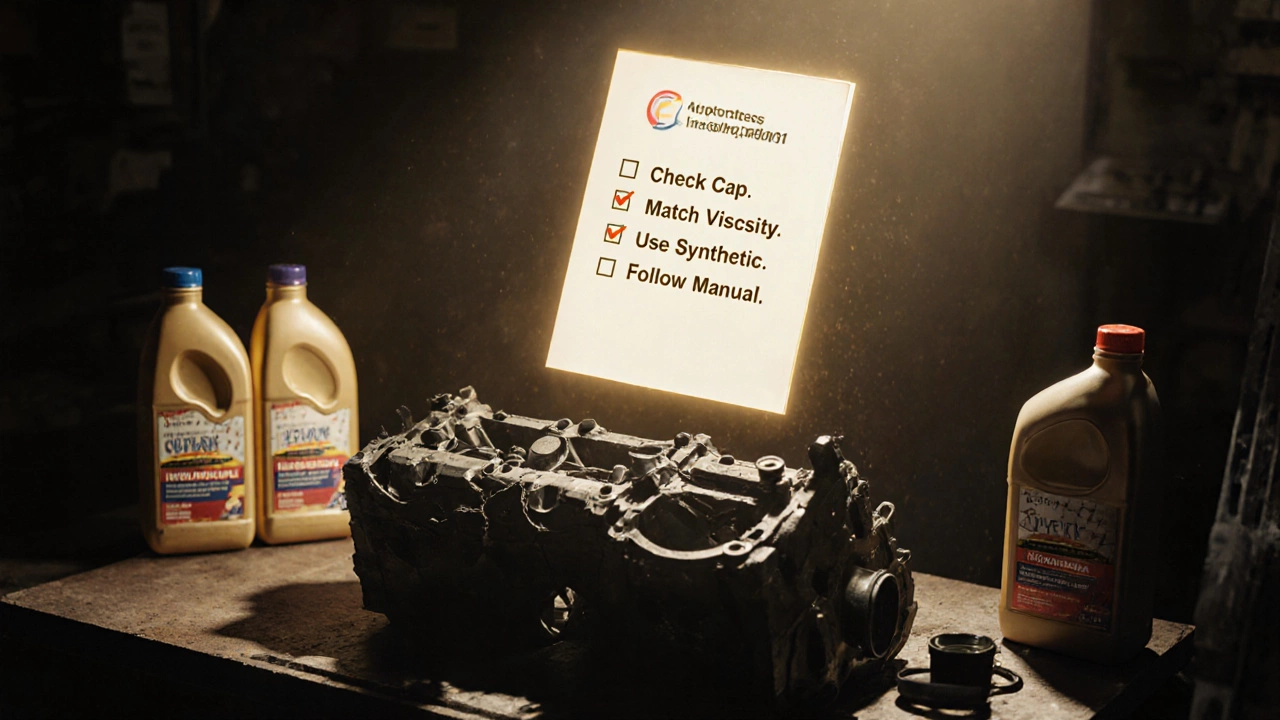 Nov, 16 2025
Nov, 16 2025
Every time you pop open your hood to check the oil, you might wonder: does it really matter what kind I put in? Can I just grab whatever’s on sale at the gas station? The short answer is yes - it matters a lot. Using the wrong oil isn’t just a minor oversight. It can cost you thousands in repairs, slash your engine’s lifespan, and even leave you stranded on a winter morning in Hamilton.
Why Engine Oil Isn’t Just Oil
Engine oil isn’t like motor oil from 1985. Today’s engines run hotter, tighter, and under more pressure than ever. Modern turbocharged engines, direct fuel injection, and variable valve timing demand precise lubrication. That’s why oil isn’t one-size-fits-all. It’s engineered with specific additives, base stocks, and viscosity ratings to protect components that didn’t even exist 20 years ago.Think of it like this: you wouldn’t put diesel in a gasoline engine. Same logic applies to oil. The wrong type can cause sludge buildup, poor fuel economy, overheating, or even catastrophic bearing failure. Your owner’s manual isn’t just a suggestion - it’s the manufacturer’s engineering blueprint for your engine’s survival.
What the Numbers on the Bottle Really Mean
You’ve seen labels like 5W-30, 0W-20, or 10W-40. Those aren’t random numbers. They’re viscosity grades defined by the Society of Automotive Engineers (SAE). The number before the W (winter) tells you how well the oil flows when cold. The number after tells you how thick it stays when hot.For example, 0W-20 flows like water in sub-zero temperatures but still protects like a thicker oil when the engine hits 200°F. That’s critical for modern engines with tight tolerances. If you use 10W-40 in a car that needs 0W-20, you’re forcing the oil pump to work harder during cold starts - and that’s when 80% of engine wear happens.
Most cars made after 2010 require 0W-20 or 5W-30 synthetic. Older vehicles (pre-2000) often use 10W-40. Using thicker oil than recommended doesn’t give you “extra protection.” It creates more friction, lowers fuel economy, and can trigger oil pressure warnings or even damage the oil pump.
Synthetic vs. Conventional: What’s the Difference?
Synthetic oil isn’t just a marketing term. It’s chemically engineered from purified base stocks, giving it superior stability, flow, and resistance to breakdown. Conventional oil is refined from crude and contains impurities that turn into sludge over time.Here’s what synthetic oil does that conventional can’t:
- Resists oxidation at high temperatures (critical for turbochargers)
- Flows faster at startup (reduces dry friction in the first 30 seconds)
- Stays stable longer (up to 15,000 miles vs. 5,000 for conventional)
- Contains advanced detergents that clean deposits instead of letting them build up
Some manufacturers now require synthetic oil - and using conventional oil voids your warranty. Even if your car is out of warranty, synthetic oil reduces long-term wear. A 2023 study by the American Automobile Association found synthetic oil reduced engine wear by 47% over 100,000 miles compared to conventional.

What Happens When You Use the Wrong Oil
Let’s say you’re low on oil and the only bottle nearby is 10W-40, but your car needs 0W-20. You top it off. What’s the real risk?One time? Probably nothing noticeable. But over months or years, here’s what happens:
- Sludge buildup: Thick oil doesn’t flow through narrow passages in the valvetrain or oil galleries. It leaves behind sticky residue that clogs oil screens and restricts flow.
- Increased friction: Thicker oil creates more drag on moving parts. That means your engine works harder, burns more fuel, and runs hotter.
- Timing chain wear: Modern engines use hydraulic tensioners that rely on precise oil pressure. Wrong viscosity = inconsistent tension = chain stretch or failure.
- Oil pump damage: The pump can’t move thick oil fast enough during cold starts. It starves critical bearings, leading to scoring or seizure.
In 2024, a Canadian automotive repair chain reported a 31% increase in oil-related engine failures in vehicles that had been serviced at non-dealer shops using incorrect oil. Most of these were owners who thought “any oil will do.”
How to Pick the Right Oil - Step by Step
You don’t need to be a mechanic to get this right. Here’s how to pick the correct oil every time:- Check your owner’s manual. Look under “Maintenance” or “Fluids.” It will list the exact viscosity and specification (like API SN, SP, or ACEA C3).
- Look at the oil cap. Most manufacturers print the recommended oil type right on the engine oil filler cap.
- Use the API service rating. For gasoline engines, look for API SP (current standard). Older ratings like SN or SM are acceptable only if your car is pre-2020.
- Stick to synthetic. Unless you drive a classic car with a high-mileage engine, synthetic is the only smart choice today.
- Don’t mix brands. Different additives can react poorly. If you switch brands, do a full oil change - don’t top off with a different one.
Pro tip: If you’re unsure, take your VIN to a dealership or trusted shop. They can pull your exact factory specs using diagnostic software. It takes 2 minutes and saves you from costly mistakes.
What About High-Mileage Oil?
If your car has over 75,000 miles, you might see bottles labeled “High-Mileage Oil.” These contain seal conditioners to reduce leaks and extra detergents to clean sludge. But they’re not magic.They’re still synthetic or synthetic-blend oils - just with added additives. If your engine isn’t leaking or burning oil, you don’t need it. In fact, some high-mileage oils use thicker viscosity than recommended, which can hurt performance in newer engines. Only use them if you have a confirmed oil leak or excessive consumption.

Common Myths About Engine Oil
- Myth: “Thicker oil protects older engines better.” Truth: Older engines need the same viscosity they were designed for. Thicker oil just increases wear on worn components.
- Myth: “I can extend oil changes if I use synthetic.” Truth: Synthetic lasts longer, but you still need to change it based on time or mileage - not just because it looks clean. Contaminants build up regardless.
- Myth: “All synthetic oils are the same.” Truth: There are Group III, Group IV (PAO), and Group V ester-based synthetics. Not all are equal. Stick to OEM-approved specs.
What to Do If You Already Used the Wrong Oil
If you accidentally used the wrong oil once, don’t panic. But don’t ignore it either.- If you used a slightly thicker oil (e.g., 5W-30 instead of 0W-20) and drove less than 500 miles, drain and replace it as soon as possible.
- If you used a completely wrong type (like diesel oil or 20W-50), don’t drive the car. Have it towed and get a full oil change and flush.
- After a wrong-oil incident, monitor for unusual noises, warning lights, or smoke. These could signal early damage.
Most engines can survive one mistake - if you fix it fast. But repeated use of the wrong oil? That’s how you end up with a $6,000 engine rebuild.
Final Rule: Follow the Manual. Always.
Your car’s manual isn’t a suggestion. It’s the result of millions of dollars in testing, engineering, and real-world durability trials. The oil type listed is the only one guaranteed to protect your engine under all conditions - from -30°C winters in Ontario to summer traffic jams in Toronto.There’s no shortcut. No “it’s just a little thicker” excuse. No “I’ve been doing this for years.” Engines today are too precise for guesswork. Using the right oil isn’t about saving a few bucks at the pump - it’s about keeping your car running for 200,000 miles instead of 80,000.
Next time you’re tempted to grab the cheapest oil on the shelf, remember: you’re not saving money. You’re betting your engine’s life on a gamble you can’t afford to lose.
Can I use synthetic oil in an older car?
Yes, you can - and you should. Modern synthetic oils are fully compatible with older engines. In fact, they reduce sludge and wear better than conventional oil. The only exception is if your engine has major leaks or is burning oil - then you might want to use a high-mileage synthetic blend with seal conditioners.
Is it okay to mix synthetic and conventional oil?
Technically, yes - they won’t explode or damage the engine. But it’s not smart. Mixing them dilutes the benefits of synthetic oil and can cause additive conflicts. If you’re low, top off with the same type. If you’re switching, do a full change.
What happens if I use 5W-30 instead of 0W-20?
In cold weather, 5W-30 will flow slower than 0W-20, increasing engine wear during startup. You’ll also see a small drop in fuel economy - about 1-2 MPG. Over time, this can lead to carbon buildup in direct-injection engines. It’s not an emergency, but it’s not ideal either.
How often should I change my oil if I use synthetic?
Most manufacturers recommend oil changes every 10,000 to 15,000 miles with synthetic oil. But check your manual. Some require changes every 7,500 miles, even with synthetic, if you drive in dusty conditions, tow heavy loads, or make frequent short trips. Don’t rely on oil life monitors alone - they’re estimates.
Does the brand of oil matter?
The brand matters less than the specification. Look for API SP or ILSAC GF-6 certification and the viscosity your car requires. Major brands like Mobil 1, Castrol, Pennzoil, and Shell all meet these standards. Avoid obscure brands that don’t list certifications on the bottle.